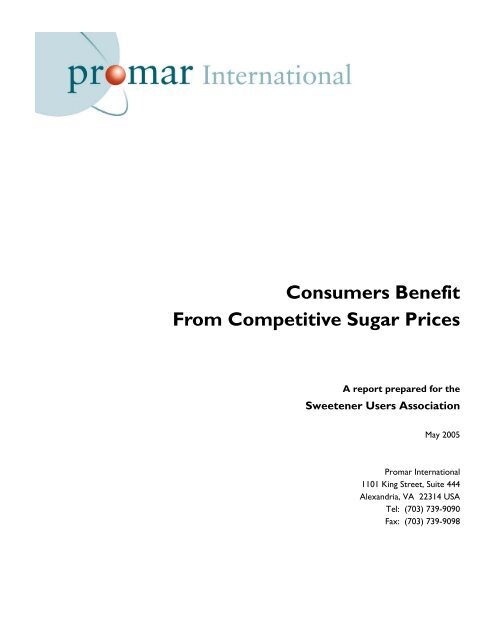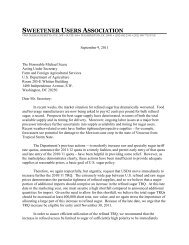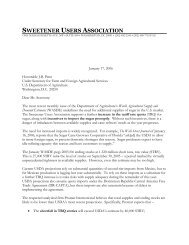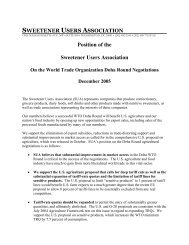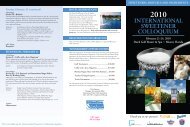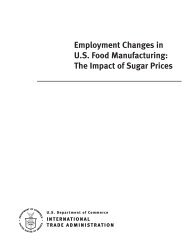Consumers Benefit From Competitive Sugar Prices - Sweetener ...
Consumers Benefit From Competitive Sugar Prices - Sweetener ...
Consumers Benefit From Competitive Sugar Prices - Sweetener ...
Create successful ePaper yourself
Turn your PDF publications into a flip-book with our unique Google optimized e-Paper software.
<strong>Consumers</strong> <strong>Benefit</strong><strong>From</strong> <strong>Competitive</strong> <strong>Sugar</strong> <strong>Prices</strong>A report prepared for the<strong>Sweetener</strong> Users AssociationMay 2005Promar International1101 King Street, Suite 444Alexandria, VA 22314 USATel: (703) 739-9090Fax: (703) 739-9098
<strong>Consumers</strong> <strong>Benefit</strong> <strong>From</strong> <strong>Competitive</strong> <strong>Sugar</strong> <strong>Prices</strong>A report prepared for the<strong>Sweetener</strong> Users AssociationCONTENTSEXECUTIVE SUMMARY 1SECTION 1: THE CONSUMER PASS-THROUGH ISSUE 2SECTION 2: SUGAR IN THE FOOD BUSINESS 32.1 Profitability of food processing 32.2 How companies price their products 42.3 Significance of sugar as an ingredient 52.4 The structure of U.S. sugar use 6SECTION 3: THE PRICE EVIDENCE 83.1 <strong>Sugar</strong> price data 83.2 <strong>Prices</strong> of sugar-containing products 11SECTION 4: CONCLUSIONS 17
<strong>Consumers</strong> <strong>Benefit</strong> <strong>From</strong> <strong>Sugar</strong> Price DeclinesEXECUTIVE SUMMARYConsumer prices for foods and beverages eventually reflect changes, whether positive ornegative, in the cost of sugar. If food manufacturers could ignore changes in the cost of sugar,they could ignore changes in the cost of other ingredients, labor, energy and other inputs; setprices wherever they want; and be immensely profitable. Yet according to the respected ValueLine Investment Survey, food industry profitability is about in the middle range for all U.S.industries.It is difficult to see price adjustments. The way in which cost savings get passed on to theconsumer depends on the type of product and how it is marketed. Cost savings to consumerscan be through increased couponing, more frequent specials, or an outright price reduction. Inmany cases, the savings just offset rising costs for labor, energy or other inputs. Labor costsaccount for the largest share of the retail food dollar – 37% – and as wages go up with theunderlying 2-3% inflation rate, food prices go up even if some ingredient costs are declining.About 27% of the sugar used in the United States is purchased at retail, mostly in five-poundbags. Historically, the retail price for sugar has clearly moved up or down in tandem with theproducer price. For the last five years, the retail price has remained stuck at about 42 cents perpound due to greater concentration in both grocery retailing and sugar processing. But thelonger-term Consumer Price Index for sugar and sweeteners indicates that consumers canbenefit from any reduction in sugar prices.The available price data for sugar-containing products also supports the conclusion thatdownward changes in sugar prices are passed through to consumers. While rising costs forlabor, energy, packaging and other inputs have continued to push food prices up, the increases inthe price indexes for sweetened foods and beverages since 1996 are well below the increases forother food categories due to the decline in sugar prices since 1996. For these products, lowersugar costs have offset increases for other inputs.We see further evidence of how consumers benefit in the aftermath of the 2002 reform of thepeanut program, with its 42% price support cut. Lower peanut costs resulted in a fall in peanutbutter prices and a consequent increase in consumption, which will also increase peanutproducer incomes, as U.S. peanut production continues to grow.1
<strong>Consumers</strong> <strong>Benefit</strong> <strong>From</strong> <strong>Sugar</strong> Price DeclinesSECTION 1:THE CONSUMER PASS-THROUGH ISSUEIn 30 years of policy debates since New Deal-era sugar programs were temporarily abandoned in1974, one argument has come up again and again: whether consumers would really benefit froma reduction in the price of sugar. This is the so-called consumer “pass-through” issue. Wouldfood and beverage manufacturers, wholesalers, or retailers just pocket the savings themselves, orwould the lower ingredient costs ultimately be passed along to the final consumer?Answering this question requires looking at various types of evidence:• Wholesale and retail sugar prices,• Retail prices of sugar-containing products like candy or breakfast cereal,• Profits of food and beverage companies, and• How manufacturers and retailers set product prices.For most food products, the cost of the sugar in a single package or serving is small relative tothe price of the product, so it can be hard for the average person to believe that reducing theproduction cost of that product by a fraction of a cent as a result of a lower sugar price is goingto affect the price he or she pays.It does, though. In this paper we review the evidence and demonstrate why changes up or downin the cost of sugar (or any other ingredient, for that matter) are ultimately passed along toconsumers.Of course, food and beverage companies that have campaigned for sugar program reform wouldalso benefit from competitive pricing. Sweetened products have to compete with a whole rangeof other food and snack items. Lower costs permit lower pricing and/or greater promotionalexpenditures, leading to higher sales and improved profits.We therefore begin by describing how sugar fits in as an input for food and beveragemanufacturers, and then review all the price evidence that is available.2
<strong>Consumers</strong> <strong>Benefit</strong> <strong>From</strong> <strong>Sugar</strong> Price DeclinesSECTION 2:SUGAR IN THE FOOD BUSINESS2.1 Profitability of food processingThere is a basic flaw in the argument that U.S. food and beverage companies would just pocketany cost savings resulting from reform of the sugar program. <strong>Sugar</strong> is just one of the manyingredients that go into foods. If manufacturers can ignore changes in sugar costs, they canignore changes in the cost of flour, vegetable oil, milk, packaging, labor, energy and every otherinput.If manufacturers could ignore changes in all these costs, they could set prices to achievewhatever profit level they desired. And yet food and beverage companies are not particularlynoted for their profitability, which is about in the middle of the range for American industries.The Value Line Investment Survey tracks the financial performance of all major publicly tradedcompanies and evaluates them both individually and by sector. Value Line published a quarterlyanalysis of companies involved in food and beverages on August 6, 2004. As the charts belowindicate, the average net profit margin of food processors from 2000 through 2004 was less than6%. For wholesalers and grocery stores it was 1.9% and for soft drink companies 10.8%.Average return on total capital was 12.0% for food processors, 12.5% for wholesalers, 8.6% forgrocery stores, and 16.8% for soft drinks (which these days barely use any sugar at all). Theseare well within the norms for American businesses. The averages for Value Line’s IndustrialComposite (680 industrial, retail and transportation companies) were a net profit margin of 6.1%and a return on total capital of 10.4%.Average net profit margin: 2000-2004Average return on total capital: 2000-2004percent181614121086percent18161412108644220FoodprocessingFoodwholesalersGrocerystoresSoft drinks0FoodprocessingFoodwholesalersGrocerystoresSoft drinksFood manufacturing is a very competitive sector. There are a lot of players and they are all afterthe consumer’s dollar. <strong>Consumers</strong> have lots of choices of what to buy and where to buy it, andthe rise of the big discount retailers in recent years has proven this proposition to manufacturersin many different industries.3
<strong>Consumers</strong> <strong>Benefit</strong> <strong>From</strong> <strong>Sugar</strong> Price Declines2.2 How companies price their productsMost businesses operate with some type of budgeting process that looks out at least a year ortwo ahead. They project costs for raw materials, manufacturing, distribution, advertising, etc.,and they project sales of their various product lines based on past experience. They establishtargets for pricing of their products that will cover all their costs and provide a desired rate ofprofit relative to sales, capital employed, or some other metrics. They then negotiate with theirmajor customers, and these negotiations have many dimensions, including not just productpricing but supply chain collaboration, promotional activities, and various contingencies.Things seldom turn out exactly as projected. Costs may end up higher or lower, and the same istrue for sales. <strong>Consumers</strong> after all have many choices, and new choices appear every year.When costs turn out lower for some reason, companies can either keep the extra net revenueas profit, invest in research and new product development, use some of it for additionaladvertising and promotion to increase sales and market share, and/or reduce prices with thesame objective in mind. Usually it is some combination of all four initially, but eventuallycompetitive pressures tend to drive prices to whatever level provides the normal rate of returnin that industry.It can be difficult to see price adjustments. The way cost savings get passed on to the consumerdepends on the type of product and how it is marketed. It can be through increased couponing,more frequent specials, packaging or product changes, or an outright price reduction. In manycases the savings just offset rising costs for labor, energy or other ingredients. Labor costsaccount for the largest share of the retail food dollar – 37% – and as wages go up with theunderlying 2-3% inflation rate, food prices go up even if some ingredient costs are declining.Some product price changes also occur in five or 10 cent increments – in vending machines forexample. The price of a candy bar or soft drink sold in a vending machine will not drop by apenny if ingredient costs fall. But in supermarkets or restaurants, where most food and softdrinks are purchased, specials and discounts are common.<strong>Consumers</strong> can therefore take advantage of food processors’ actual lower costs by choosingwhere to shop and what to purchase. The same candy bar can be $1.00 in an airport, $0.69 in aconvenience store, or three for a dollar on sale at a supermarket. And even for consumer sizedpackages of refined sugar there is wide price variability, as illustrated by the prices we found on asingle day in October in Northern Virginia shown in the table below.<strong>Sugar</strong> in the standard 5-pound bag ranged from about 38 cents to 48 cents per pound, and a 10-pound bag at Costco was only 36.9 cents per pound. Strangely, a 10-pound bag at two localgrocery chains was more expensive on a per pound basis than the 5-pound bag. There are waysto spend even more on sugar. Confectioners sugar and light or dark brown sugar ranged from 594
<strong>Consumers</strong> <strong>Benefit</strong> <strong>From</strong> <strong>Sugar</strong> Price Declinesto 89 cents per pound in our survey. Organic, raw, and turbinado sugar were $1.49 - $2.53 perpound.<strong>Sugar</strong> prices in Northern Virgina: October 2004Packagesize(pounds)Costco Walmart Shoppers Safeway Giant Rite AidNational Store National Store National Store National Store Nationalbrand brand brand brand brand brand brand brand brand- - - - - - - - - - - - - - - - - - - - - - - - - - - - cents/pound - - - - - - - - - - - - - - - - - - - - - - - - - - - -2 59.5 48.5 74.5 62.5 84.55 37.6 47.8 39.8 39.8 45.8 47.8 39.810 36.9 52.8 44.0 74.9 39.9 38.925 34.850 32.82.3 Significance of sugar as an ingredientThe 2002 Economic Census gives us an industry by industry picture of the role that sugar plays inthe cost structure. This survey by the Department of Commerce reports expenditures onmaterials along with a variety of other economic indicators. For food industries that use sugar,expenditures on materials (which include packaging as well as food ingredients) average about50% of the wholesale value of the final products they ship out. <strong>Sugar</strong> generally accounts for lessthan 10% of purchased materials, even for high sugar content items like confectionery, andtherefore less than 5% of the shipment value. By the time wholesalers and retailers add theirmarkups, the share of the retail price accounted for by sugar as an ingredient is quite small.<strong>Sugar</strong>’s share of materials purchased1210percent86420Chocolate from cocoaNon-chocolate confec.Flour mixes & doughConfec. from chocolateCookies & crackersFrozen cakes, piesCommercial bakeriesOther miscellaneousIce cream, frozen dessertCondensed, evap. DairyFlavoring syrupsMayo, dressing, sauceFluid milkFruit & veg. canning5
<strong>Consumers</strong> <strong>Benefit</strong> <strong>From</strong> <strong>Sugar</strong> Price DeclinesOf these sugar-using industries, the companies that process their own chocolate confectioneryfrom cocoa beans had the highest dependence on sugar, but even in these cases, sugar onlyaccounted for 10.5% of total material purchases and 5.6% of the value of a company’s shipments.Thus to get the average cost of its products down one percent, a company’s sugar costs wouldhave to decline about 20%. But even a small decline in costs would be noticeable for anindustry that spent $230 million on sugar in 2002 according to the Economic Census. 1The next three industries had sugar costs at 8-9% of total material costs and 3-4% of shipmentvalue. These industries are the sugar-intensive manufacturing of non-chocolate confectionery,confectionery made from purchased chocolate and flour mixes and doughs. For cookies andcrackers, sugar represents 7.4% of total material costs.After that, sugar’s significance drops off rather rapidly and there are another 11 industries notshown in the chart for which sugar is 0.5% or less of total material costs. But collectively, the 25industries for which the Census breaks out sugar as a material accounted for 4.9 million tons ofsugar use, or almost 80% of the 6.2 million tons delivered in other than consumer sized packages.If a lower sugar support price reduces the cost of that 4.9 million tons of sugar, it will bereflected in shipment values, i.e. wholesale prices, and on through the marketing chain to the finalconsumer.2.4 The structure of U.S. sugar useIn order to understand how sugar prices work through to the consumer level, one needs to havea picture of how sugar is sold. USDA collects data every month on the end uses and the form ofpackaging of the sugar that is sold – consumer size, packages of 50 pounds or more, or bulkshipments in rail cars or trucks. The breakdown for the most recent calendar year is shown inthe chart on the next page.During 2003, there were total sales of 8.57 million tons of refined sugar, of which 2.33 milliontons or 27% were in consumer sized packages of less than 50 pounds. This form of packaging isabout 8% lower than in 1970, despite a 42% increase in the U.S. population since that year,mostly because people do much less home food preparation today.Bulk shipments to food and beverage manufacturers accounted for 3.79 million tons or 44% ofU.S. sales (with beverages accounting for less than 3%). This is down about 2 million tons from1970 because high fructose corn syrup replaced sugar in most caloric soft drinks. Finally,1 Data is not shown for the breakfast cereal industry for which sugar costs in past Census reports havenormally been in the mid-teens as a percent of total material costs. The 2002 Census showed costs at26% of the total, but there was clearly incomplete data because the value and tonnage of sugar wereinconsistent and shipment value dropped to $9 billion from $11 billion the three prior years.6
<strong>Consumers</strong> <strong>Benefit</strong> <strong>From</strong> <strong>Sugar</strong> Price Declinespackages 50 pounds or greater represented 2.45 million tons or 29%. Most of this went tosmaller companies making candy, baked goods, etc., or to restaurants and institutions for foodservice use.2003 <strong>Sugar</strong> Sales By Package Size(million tons)Consumer sizepackages, 2.33Bulk, 3.79Packages 50+pounds, 2.457
<strong>Consumers</strong> <strong>Benefit</strong> <strong>From</strong> <strong>Sugar</strong> Price DeclinesSECTION 3:THE PRICE EVIDENCE3.1 <strong>Sugar</strong> price dataThere are three sugar prices that can be analyzed in order to understand how retail prices areaffected by changes at the producer level. The United States produces both cane sugar and beetsugar. <strong>Sugar</strong>cane mills produce raw sugar which is sent to refineries where the final white sugarproduct is produced. Most sugar cane refineries are on the East, West or Gulf Coasts becausewe also import raw sugar from other countries. (Note: Because the U.S. sugar program hasencouraged more domestic sugar beet production and imports have been reduced throughdeliberate government policy, many cane refineries have closed.)There is a commodity futures market for raw sugar and prices are reported daily for differentmonths of delivery. The price for the nearest month is considered the best representation of thevalue of raw sugar, delivered to a coastal refinery. This price is called the “Number 14” after thedesignation of the futures contract.When sugar beets are processed, the end result is white refined sugar, with no intermediate rawsugar stage. The price at the factory is reported weekly by a publication called Milling & BakingNews. Their reporters phone both buyers and sellers of refined beet sugar and then publishtheir estimate of prices for bulk shipments at plants in the Midwest and on the West Coast,usually in the form of a one-cent range. USDA and others use the lower end of the Midwestrange as the best single indicator of the wholesale market price for refined sugar.The Midwest location is used because that is where beet sugar production is concentrated andwhere a lot of food processing facilities are located, so it is a competitive market. It isrecognized that prices for refined sugar at coastal refineries are generally higher, and that pricespaid by end users also reflect the cost of transporting the sugar from the factory or refinery.The third published price series is the retail price. The Bureau of Labor Statistics (BLS) publishesthis monthly price in connection with the nationwide survey it conducts each month in order tocalculate the Consumer Price Index (CPI). This survey covers all food retailer, including massmerchandisers. BLS actually publishes two price series – one for all package sizes and one for 33-80 ounce packages. The latter captures primarily the traditional 5-pound bag, but also includes 4-pound and 2-kilogram packages. The former series includes everything from 1 and 2-poundboxes to 100-pound bags. Since most consumers purchase the 5-pound bag, we usually use thatseries.The chart below compares the retail price to the monthly average Midwest beet sugar price atthe factory from 1985 to the present. Up until about 1998, the two refined price series trackedeach other rather closely, as one can see in the chart. When the price received by the sugarproducer went up, the retail refined price went up, with a lag of a few months. When the8
<strong>Consumers</strong> <strong>Benefit</strong> <strong>From</strong> <strong>Sugar</strong> Price Declinesproducer price went down, the retail price went down, again with a lag. If one graphs pricesfrom 1970 to 1985, a similar pattern prevails.This direct linkage of the retail price to the producer price was always the most convincingargument that consumers are directly affected by changes in the sugar support price. Since thelate 1990s, however, the linkage seems to have been broken. The retail price has fluctuatednarrowly around roughly 42 cents per pound (or $2.10 for a 5-pound bag) despite significant upsand downs in the producer price. The two-dollar price point for a 5-pound bag may have aninfluence. Stores can put a brand on sale for $1.99 to attract shoppers, while keeping the normalprice above that level. But many analysts attribute the inflexibility to the increased market powerof retailers due to consolidation in the retailing sector.However, there has also been a great deal of concentration in the sugar processing industry itself,and it is not implausible that the industry could be partly responsible for the recent inflexibility ofretail sugar prices. It is possible that while the bulk industrial sugar market has remainedcompetitive, the marketing of sugar for retail sale has become less so. Quoted wholesale pricesfor refined sugar reflect what large bulk customers pay, not the wholesale price for consumerpackaged sugar paid by retailers or distributors. These prices are typically higher but are notreadily available. Whatever the cause, the spread between the two price series has jumped fromabout 10 cents/pound in the late 1980s to almost 20 cents/pound in 2004.9
<strong>Consumers</strong> <strong>Benefit</strong> <strong>From</strong> <strong>Sugar</strong> Price DeclinesIt should be noted that the relationship of the retail price to the raw sugar price is much looser.Refined cane sugar prices have to compete with refined beet sugar prices, and the two almostalways move together. The raw sugar price is the cost of the raw material for refiners but doesnot always move in parallel with the refined sugar price which is heavily affected by the size of thesugar beet crop and the resulting supply of competing beet sugar. Periods like the late 1980s or2000-2001 were very challenging for refiners because a depressed refined market made itvirtually impossible to cover their costs for raw sugar and all the other inputs needed to makerefined cane sugar.If retail sugar prices remain inflexible, the way to address that is through measures that deal withthe competitiveness of the marketplace, like antitrust policy. But even under current conditions,one can see direct evidence that sugar price support affects consumers.The chart below compares the CPI for all items, for food and beverages, and for sugar andsweeteners since 1970. The 1982-84 period, just after the current sugar program wasintroduced, equals an index of 100. The 1970s were periods of rapid food price inflation and thisis apparent in the food and beverage index being above the all items index during that period.The effects on the sugar price index of the two world shortages in 1974 and 1980 are alsoillustrated in the chart below. Since the early 1980s, however, the food index has gone up intandem with the index for all items. The high sugar price support level established in 1982 hasstayed constant for the last 22 years, and partly as a result, the index for sugar and artificialsweeteners has not gone up as much as that for all foods. In short, consumers do benefit if sugarprices are reduced or do not go up.200U.S. Consumer Price Index(1982-84=100)All Items150100Food &Beverages<strong>Sugar</strong> &sweeteners5001973 1978 1983 1988 1993 1998 200310
<strong>Consumers</strong> <strong>Benefit</strong> <strong>From</strong> <strong>Sugar</strong> Price DeclinesThis graph clearly refutes the sugar lobby’s central claim that product prices do not rise or fall inrelation to changes in ingredient costs. If that were so, the sugar and sweetener index shouldhave gone up in tandem with the index for all foods and beverages. It did not. Instead, theconstant price support level and periods of lower prices like 1999-2000 were obviouslytranslated into savings for consumers relative to all other food and beverage items.The benefit to consumers of lower sugar prices is clearly evident in countries like Canada, whichimports sugar at the world price, and Australia or Brazil, are producing sugar competitively atrecent world price levels.3.2 <strong>Prices</strong> of sugar-containing productsThe American <strong>Sugar</strong> Alliance (ASA), representing sugar producer interests, often uses a chartshowing that while raw and refined sugar prices have declined since 1990 or 1996, prices ofvarious sugar-containing products have risen. ASA’s choice of those two years for comparisonwas not accidental – 1990 had the highest refined sugar prices since the world shortage of 1980,and 1996 was second highest. Naturally, sugar prices subsequently declined. More importantly,prices of the sugar-containing products they cite have gone up by less than the increase for allfoods and beverages or for all items. This is strong evidence that a decline in or moderation ofsugar prices does have a negative effect on food prices.As one might have guessed from the previous chart showing the slow but relentless increase inthe overall consumer price level, the main determinants of processed food prices are notcommodity costs. Today the farm value of food ingredients makes up less than 20% of whatconsumers actually spend for food.According to USDA, in 2002 consumers spent $709 billion for domestically produced foods,including both food at home and food away from home. Of that total, $577 billion or 81% wasaccounted for by what the Department calls the marketing bill. The chart below plots the farmvalue and marketing bill, and it is clear that the farm share has steadily declined. This is primarilybecause impressive long-term productivity growth in agriculture continues to give us decliningreal prices for all farm commodities. But it is also attributable to the fact that we demand moreconvenience, do less cooking at home, and eat more meals away from home.The main components of the food dollar are illustrated in the second chart on the next page.The marketing bill is comprised of everything but the farm value. Labor is obviously the mostimportant at 37%, followed by packaging at 8 percent. Then there are several categories thateach account for 4-5% of the final cost of food to the consumer – depreciation, advertising,transportation, rent, and pre-tax profits.11
<strong>Consumers</strong> <strong>Benefit</strong> <strong>From</strong> <strong>Sugar</strong> Price DeclinesConsumer expenditures fordomestically produced farm foods$ billion800700600500400Marketing300bill2001000Farm value1970 1975 1980 1985 1990 1995 2000Components of the U.S. food dollar: 2002Labor37%Farm value19%Other11%Packaging8%Pre-tax profits5%Net rent4%Transportation4%Advertising4%Depreciation4%Fuel & electricity4%12
<strong>Consumers</strong> <strong>Benefit</strong> <strong>From</strong> <strong>Sugar</strong> Price DeclinesWhen costs and prices of almost everything in the economy are going up by 2-3% per year, itbecomes very difficult to trace the impact of a change in the cost of a single food ingredient onthe final retail price.There are some examples, however. The Bureau of Labor Statistics publishes a limited amountof price data from the surveys it conducts to prepare the Consumer Price Index. In addition tothe sugar prices mentioned above, the three sugar-containing products for which they publishprices are chocolate chip cookies, peanut butter, and ice cream. The BLS price charts for thosethree products are reproduced on the following pages.Chocolate chip cookie prices are essentially the same in 2004 as they were in 1990. There havebeen some ups and downs, but the comparative flatness of that price series is partiallyattributable to the fact that sugar prices have been flat.Peanut butter prices are interesting because they visually demonstrate how both increases anddecreases in farm prices are reflected at retail. In 1990, the combination of a poor peanut cropand high prices for both peanuts and sugar led to a significant increase in retail peanut butterprices, but those subsequently came down as costs returned to normal. More recently, one cansee the decline that has taken place since the 2002 farm bill as a result of the buyout of thepeanut marketing quotas and the 42% decrease in the peanut price support level. Equallyimportant, sales of peanut butter and other peanut products have gone up as a result of the pricecut. This increase in demand has benefited producers, processors and consumers. Meanwhile,producers’ incomes have been safeguarded through direct payments under the reformed peanutprogram.In the case of ice cream, prices have risen sharply since the mid-1990s due principally to thedoubling of butterfat prices.Soft drinks are another good example of how consumers benefit from moderation or declines iningredient costs. BLS does not publish a long-term price series for carbonated soft drinks, butthe price index is charted on page 15. It graphically demonstrates the impact of the industry’sswitch from sugar to high fructose corn syrup (HFCS) in the 1980s, and the subsequent flatprices for that sweetener. Since the 1982-84 base period for the index, soft drink prices haverisen less than 30%, while the overall CPI has gone up 90%.Another clear sign of the significance of price competition is that in 2004, Beverage Digestreported that one of the leading companies lost market share precisely because it increasedprices more than competing beverage companies.13
<strong>Consumers</strong> <strong>Benefit</strong> <strong>From</strong> <strong>Sugar</strong> Price DeclinesChocolate chip cookie prices ($/pound)Peanut butter prices ($/pound)Ice cream prices ($/half gallon)14
<strong>Consumers</strong> <strong>Benefit</strong> <strong>From</strong> <strong>Sugar</strong> Price DeclinesCPI for carbonated drinks (1982-84=100)<strong>Consumers</strong> and food and beverage manufacturers have been campaigning for reform of the sugarprogram for over 20 years. One tangible result is that at least the price support level has notbeen increased during that period. Market prices for refined sugar have fluctuated mostly withina range of plus or minus 4 cents per pound. Consequently, when prices fall back from one ofthose peak levels, it helps to moderate prices of sugar-containing products for a time.The American <strong>Sugar</strong> Alliance likes to contrast the fall in sugar prices since 1996 with increases inprices of sugar-containing products. The real context for those price changes is evident in thechart below, which shows that price indexes for most sugar-containing products have gone upmuch less than the CPI for all items, or the CPI for all foods and beverages.An equally important point is that wages and salaries went up an even greater 27.1% between1996 and 2003. Labor costs are the single largest cost component in food prices. Productivitygrowth in the food sector has kept food price increases well below the increase in labor andother costs.The chart demonstrates that ASA’s central argument lacks credibility. Food manufacturers have,in fact, passed through price declines, and these have moderated prices that were under upwardpressure because of other cost factors. Five of seven sugar-intensive products rose less in pricethan all foods and beverages; one rose at an almost identical rate; and the only sugar-intensiveproduct whose price rose at a faster than average rate was affected by commodity costs totallyunrelated to sugar. In short, ASA’s own evidence demonstrates that moderating sugar priceskept sugar-containing product prices from rising at a normal rate, resulting in direct, tangibleconsumer savings.15
<strong>Consumers</strong> <strong>Benefit</strong> <strong>From</strong> <strong>Sugar</strong> Price DeclinesConsumer price increases for sugar and sweetened products werevery moderate from 1996 to 200327.1Percent Increase 1996-200317.3 17.44.87.3 7.59.916.517.521.4Wages &salariesAll itemsFood &beveragesCarb.DrinksCandy, gum Cereal <strong>Sugar</strong> &sweetenersCookies,cakesOtherbakeryIce cream16
<strong>Consumers</strong> <strong>Benefit</strong> <strong>From</strong> <strong>Sugar</strong> Price DeclinesSECTION 4:CONCLUSIONSThe United States has an intensely competitive food system, and consumers benefit when undulygenerous commodity price support levels are reduced. In the most recent USDA study ofcompetition in food markets, USDA reached the following conclusion: “At the national level, ourtests provide evidence of competitive conduct in both the sale of final food products and thepurchase of farm ingredients.” 2<strong>Sugar</strong> is no exception. <strong>Consumers</strong> benefit when sugar prices are reduced. To summarize,• While sugar is a major food ingredient, it still represents a small part of the cost ofproducing most food and beverage products.• It can therefore be difficult to detect the effect of a decline in sugar prices because of theoffsetting increases in labor and other costs.• Nevertheless, food companies cannot simply ignore cost changes and set their prices atwhatever level they want. If they could, food companies would be immensely profitable,yet they are not.• Cost savings get passed on to the consumer in a variety of ways: increased couponing,more frequent specials, an offset to increased costs for other inputs, or an outright pricereduction.• The available price data and price indexes from the Bureau of Labor Statisticsdemonstrate the fact that cost reductions are passed on to consumers after a certain lag.• The Consumer Price Index for sugar and sweeteners has risen less than that for all itemsbecause the sugar support price has been frozen at its high level for many years; andduring periods of sugar price decline, indexes for sugar-containing products have risenless than the index for all foods and beverages.• Manufacturers of sweetened foods and beverages want lower sugar costs because theirproducts have to compete with many other types of food and snack products. Lowercosts lead to lower prices, greater sales volume, and greater profitability.2 A.J. Reed and J.S. Clark, Structural Change and Competition in Seven U.S. Food Markets, Economic ResearchService, USDA, Technical Bulletin Number 1881, February 2000.17


